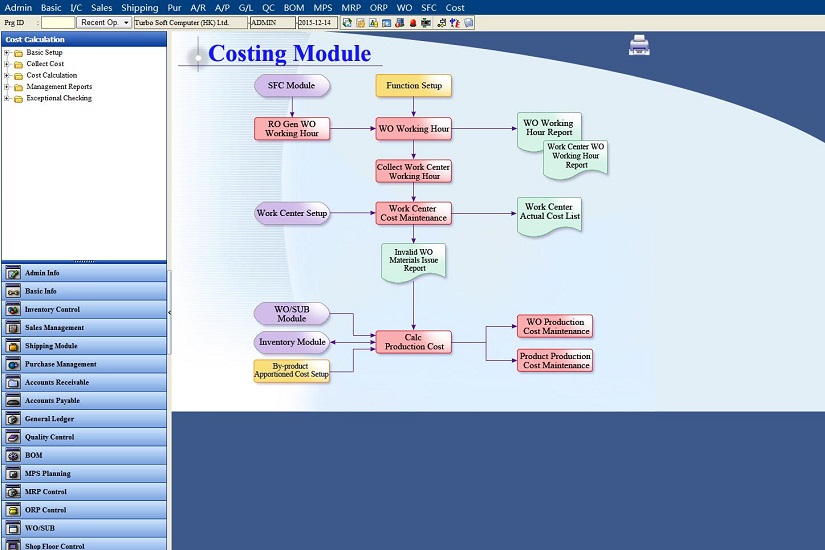Cost Calculation
 |
||
System Objectives
The economic globalization and keen competition inside and outside the country makes the profit space becoming much smaller. Therefore, the cost control is becoming more important in the point of view of manufacturers while the key issue are lower the cost and strengthen the cost control. To achieve cost control, enterprise has to make the cost forecast, cost adjustment, cost control and cost analysis, etc. However all the above tasks are back-up with comprehensive cost control system and accurate information flow.
TURBO ERP cost control system are designed to help cost controller to finish the cost control on time and effectively. The system is based on the need of modern manufacturing industries to provide flexible order and working-hour information collection, different cost calculation methods; to match with the production cost analysis reports, semi-production cost analysis reports, etc.![]()
System Functions
| . | Cost calculation can be based on monthly weighted average cost method and standard cost method. |
| . | Cost calculation can be done by each work order or by each level of semi-products of one finished product. |
| . | The types of cost can be categorized by its nature into material cost, labor cost, manufacturing cost and sub-contract cost. |
| . | Working hour information can be set by users (from Jobs Duty Note or Routing Note) and users can set the source of calculation of actual working hour (including normal finish working hour, re-work finish working hour, and scrapped working hour). |
| . | For company which is difficult to obtain actual working hour, users can choose to use the standard working hour to calculate the labor cost. |
| . | Provides generation of work order hour by manufacturing records or standard working hour of work order routing process or standard working hour of product routing process. |
| . | Provides working order hour summary which shows labor and machine hours of each work center for each month. |
| . | Can choose actual or standard apportion rates to calculate labor cost and manufacturing cost. |
| . | Can use different wage rates to calculate labor cost of different working centers. |
| . | There are 3 types of apportion methods for calculating the manufacturing cost, labor hour, machine hour and labor cost. Users can choose the apportion method according to the work center. |
| . | The calculation of manufacturing cost can include estimated WIP quantity carry forward and cost input brought forward. To estimate the WIP quantity at the end of period, the system can auto-calculate the individual material and labor cost by the information input beforehand. There are different formulate for users to choose in the calculation. |
| . | The cost calculation uses the roll-up method, which means calculating the cost of each level from lower levels to higher levels. This method can ensure the accuracy of the cost calculated. In each level, the details of the manufacturing cost and that of the lower level rolled-up will be recorded. The cost structure is clearly presented which is useful for cost analysis. |
| . | The system is flexible in a way that users can set the cost of semi-finished products to be the cost of the next higher level. Moreover, users can choose to display the cost by the sequence of the types of cost (material, labor, manufacturing cost and sub-contract cost). |
| . | Can compare the difference between the standard cost and actual cost to analyze the reason behind. Improvements can be done for achieving higher efficiency, such that actual cost can be closer to the standard cost and the cost of product will be most economical. |
| . | provides analysis and comparison of work order standard manufacturing cost and actual manufacturing cost. |
| . | Provides own level cost update, system can auto-calculate the labor, manufacturing and sub-contract cost by the standard working hour of the production schedule and the standard cost of the work center. The system can also update the information in the inventory control module. |